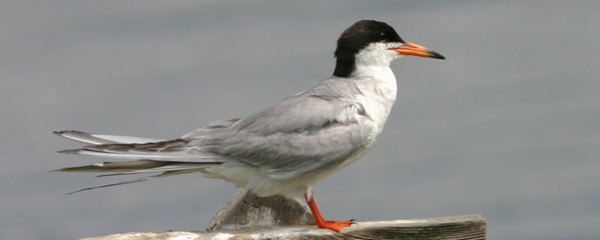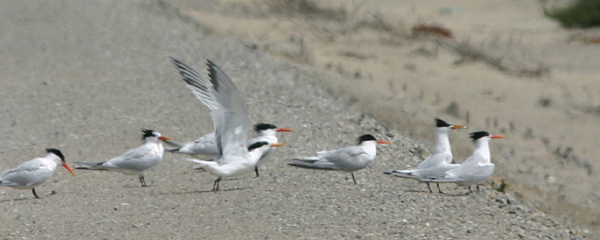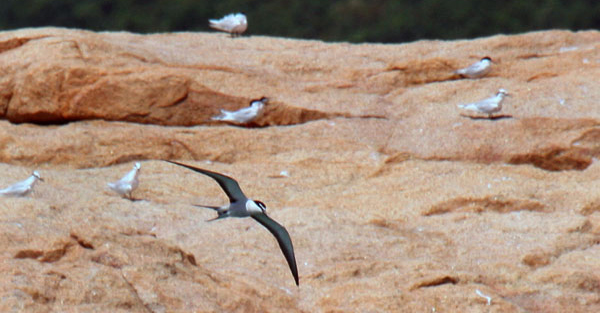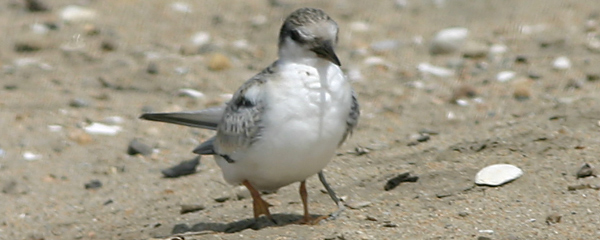Terns have it tough. Everyone in the world seems to know about gulls, but unless you’ve spent time in the company of seabirds or seabirders, you’ve probably missed out on the more lithe and lovely larids!
Terns are mostly medium-sized flying seabirds in the family Sternidae or subfamily Sterninae depending on your taxonomy. Relatives of gulls and skimmers, these sleek aerialists are usually white or gray in color with angular wings and long, pointy, sometimes slightly decurved bills. Terns often have black markings on their heads that resolve into black caps during breeding season. Separating one species of tern from another can sometimes devolve into a dissertation on mantles and scapulars but distinguishing terns from gulls is much easier. In general, terns present a much sleeker profile with sharp, narrow wings and long, sometimes forked tails. Also, watching terns hover and dive for fish along the shore is a lot more entertaining that seeing gulls squabble over scraps in a parking lot!

Forster’s Tern, Bolsa Chica, summer, by Mike

Forster’s Tern, Bolsa Chica, winter, by Charlie
Terns can be found everywhere in the world, particularly in the temperate zones. With about 44 recognized species of these long-lived larids, the best approach to understanding them lies in the various tern genera.
Terns in the genera Anous are known as noddies or noddys. These natty notch-tailed birds, which occupy colonies on tropical and subtropical coasts and islands around the world, invert the typical tern color scheme with striking dark plumage capped in white or gray.
Procelsterna terns are known as the blue-gray noddies; formerly monotypic, the Blue-gray Noddy was split with Solomonic wisdom neatly into Blue (P. cerulea) and Gray (P. albivitta). These enchanting avians of Oceanic islands are white with gray wings, black bills, and black eyes that appear rather doll-like due to black patches in front and white patches behind them.
While the White Tern (Gygis alba) and sometime subspecies, sometimes separate species Little White Tern (G. microrhyncha) are grouped with noddies, they also answer to the easy-to-remember “white terns.” This appellation is rather accurate as Gygis terns are pure white with upcurved black bills. White terns have the curious, yet effective strategy of laying single eggs in the fork of thin branches, protecting them from the depredations of rats and other island predators.
Birds in the genus Onychoprion may be called brown-backed terns, but their striking, high contrast plumage is generally black or gray. Gray-backed (O. lunatus), Bridled (O. anaethetus), and Sooty (O. fuscatus) Terns range throughout tropical oceans, with the last species found just about everywhere equatorial. The Aleutian Tern (O. aleuticus) favors warm South-Asian waters for winter but breeds, as the name suggests, around Siberia and Alaska.
The genus Sternula holds the small white terns. These dainty divers are distinguished not just by their size but by a striking head pattern of black on the crown and extending through each eye set off by a stark white forehead patch. In breeding plumage, these birds have yellow legs and equally vivid, slightly droopy bills tipped in some species with black; in winter, these bills turn black. Every continent but Antarctica has at least one small white tern species.
Chlidonias terns are referred to as marsh terns as they can often be found inland in freshwater marshes as well as along the coast. Marsh terns tend towards darker plumage than most other terns. The Whiskered Tern (C. hybridus), widespread throughout the Old World, sports an attractive plumbeous plumage during breeding season, as does New Zealand’s Black-fronted Tern (C. albostriatus), whereas Black (C. niger) and White-winged Tern (C. leucopterus) become positively ebony. Like some songbirds, these terns will take flying insects from the water’s surface or even mud.
Six extant species of crested terns in the genus Thalasseus are well known wherever they range. These daring plunge divers are denoted by their unkempt crests and dagger-sharp bills. Birds like the Greater Crested (T. bergii), Royal (T. maximus), and Elegant Tern (T. elegans) are often among the largest terns in their range.

Elegant Terns (note the shaggy crests) by Mike
The terns in the genus Sterna are generally smaller than the crested terns but known nonetheless as the large white terns, distinguishing them perhaps from the smaller Sternula species. This large group of medium-sized terns includes one bird that adds true meaning to the term bipolar: the Arctic Tern (S. paradisaea) enjoys two summers each year as it migrates from its northern breeding grounds in the uppermost reaches of North America, Europe, and Asia to the uninhabited oceans around Antarctica and back. This route, roughly 24,000 miles, represents the longest known migration of any animal. Most other Sterna terns are more retiring, but still abundant in their areas. Along the northeast Atlantic, we spend our summers separating Common Terns (S. hirundo) from their lookalike Forster’s Terns (S. forsteri)

Antarctic Terns by Charlie
There are also a number of fascinating monotypic terns. The Large-billed Tern (Phaetusa simplex) of the Caribbean and Central and South America is aptly named, with a great, gold honker of a bill. The cosmopolitan Caspian Tern (Hydroprogne caspia) has nothing to be embarrassed about in the size department either; not only does it brandish a substantial scarlet and black-tipped bill, but it also weighs in as the world’s largest tern. On the other hand, the globally-ranging Gull-billed Tern (Gelochelidon nilotica) is more modestly endowed than other terns but turns its identifying attribute to advantage by hunting insects, amphibians, and even small mammals. No tern, however, is likely to beat the Inca Tern (Larosterna inca) in a beauty contest, considering its smoldering slate plumage set off by dashing white curlicue mustachios and vermilion extremities. All terns are gorgeous seabird specimens but some simply have to be seen to be believed!

Three species of tern from Po Toi, Hong Kong: Bridled (flying), Black-naped (white crowns and black napes), and Roseate (dark crowns)














Good post, Mike! Very informative, spiced with good pics as well!
Cheers, Klaus
Oh I really have a hard time between gulls and terns, though I think we see more terns here than gulls (Madras, India).
Then again we have a gull-billed tern!
Nice post–your note about “extant” Thalasseus caught my eye: are there fossil species known? Very cool.
It’s nice to see someone asking the question “what is a tern” rather than the much more frequent “what is THAT tern”!
r
Nice!!! I highly approve this post. Do more like it.
Where was that last picture taken?
For fossil Thalasseus:
http://en.wikipedia.org/wiki/Thalasseus
Thanks all!
Nick, I appreciate the Thalasseus save. To return the favor, I’ve identified where Charlie’s triple tern shot was taken in the post.
FYI, I plan to do many more posts like this one. You can find links to the many I’ve already written on our Birds page.